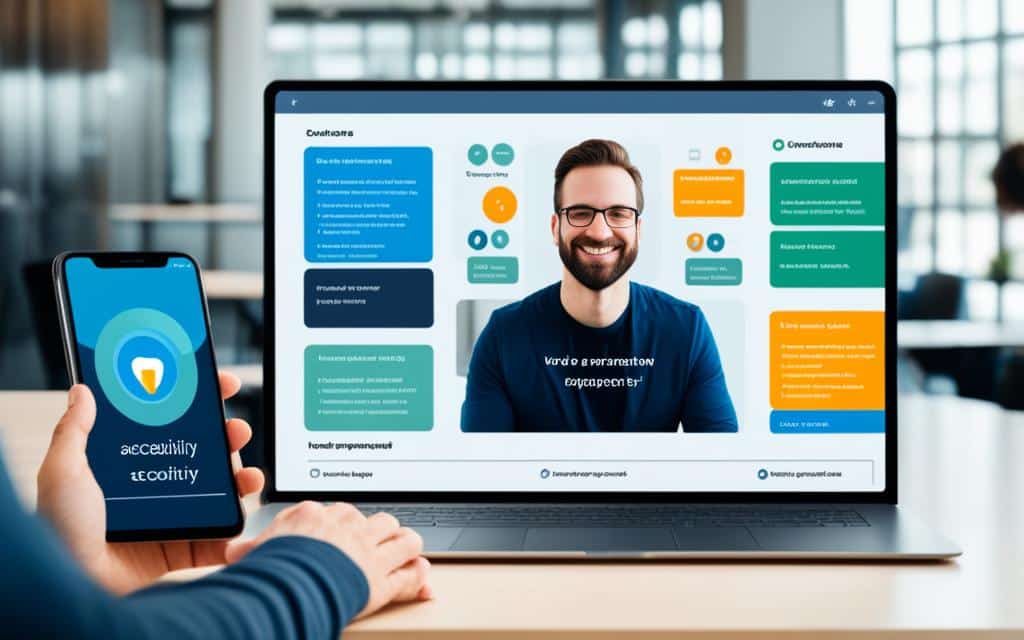Table of Contents
Inclusive design is a groundbreaking methodology that goes beyond traditional accessibility guidelines, aiming to create digital products that are usable by diverse audiences in various digital spaces. As technology becomes increasingly integrated into our lives, it is essential to ensure that everyone, regardless of their abilities or circumstances, can access and navigate digital platforms.
Unlike conventional accessibility, inclusive design takes into account the unique needs of individuals who may face barriers in using technology. This approach recognizes that disabilities and exclusion can happen to anyone and considers a diverse range of users. By identifying situations where people are excluded and designing solutions to address their needs, inclusive design strives to make digital products accessible to all.
Through inclusive design, equal access and usability become paramount considerations in the design process. The goal is to create digital spaces that cater to individuals with disabilities, temporary impairments, and diverse circumstances. By placing emphasis on clear and concise content, adaptable layouts, and intuitive navigation, inclusive design enhances the user experience for people with disabilities while benefiting a wider range of users.
Moreover, inclusive design goes beyond compliance with accessibility standards. It promotes inclusivity, opens up new markets, increases customer satisfaction, and drives innovation. By nurturing a culture of collaboration and prioritizing user research and testing, barriers to inclusive design can be overcome. Education and awareness among stakeholders also play a crucial role in fostering a digital environment that embraces accessibility for all users.
As we move towards a more connected world, inclusive design becomes a global effort. International cooperation and the implementation of policies, such as the United Nations Convention on the Rights of Persons with Disabilities, contribute to ensuring equal access to digital platforms and services. Overcoming unique obstacles faced by developing countries requires concerted efforts and shared knowledge.
By embracing collaborative processes, promoting education, and leveraging emerging technologies, inclusive design paves the way for a more accessible and equitable digital future. It empowers individuals, bridges the gap in digital access, and fosters an inclusive society. Through inclusive design, diverse audiences can fully participate in the digital realm, enhancing usability, satisfaction, and ultimately driving innovation.
The Difference Between Accessible and Inclusive Design
When it comes to designing digital products, accessibility is often the focus in ensuring that people with disabilities can effectively use them. However, accessibility guidelines may not fully address the needs of individuals with temporary disabilities or diverse circumstances that can impact their usability. This is where inclusive design steps in, taking into account the diverse experiences that can exclude individuals from effectively using interfaces.
Inclusive design goes beyond accessibility by considering the needs of a broad range of people from the outset. It is a methodology that aims to address these needs throughout the design process, rather than focusing solely on the outcome. By embracing inclusive design, designers can create digital products that can be used by a diverse group of individuals, regardless of their abilities or current circumstances.
While accessibility ensures that digital products meet certain guidelines, inclusive design fosters a more holistic and inclusive approach to design. It recognizes that disabilities and exclusion can happen to anyone and that usability barriers can arise from diverse circumstances. Inclusive design strives to eliminate these barriers and create digital products that are usable by all.
The Benefits of Inclusive Design
Inclusive design offers several advantages over traditional accessibility-focused design:
- Enhanced usability for individuals with disabilities: Inclusive design aims to provide a seamless user experience for people with disabilities, ensuring they can access information and services without barriers.
- Improved usability for individuals with diverse circumstances: By considering a wide range of experiences, inclusive design also addresses the needs of individuals facing temporary disabilities or unique circumstances.
- Better user experience for all: Inclusive design not only benefits individuals with disabilities but also improves the overall user experience for everyone, including elderly individuals and non-native speakers.
- Expanded market reach: By creating inclusive digital products, businesses can tap into new markets and attract a wider range of customers, increasing their potential reach and revenue.
- Sparking innovation: Inclusive design encourages creativity and innovation by challenging designers to think beyond the status quo and create products that cater to diverse user needs.
| Accessible Design | Inclusive Design |
|---|---|
| Focuses on meeting accessibility guidelines | Takes into account the needs of a diverse range of users from the outset |
| Prioritizes addressing the immediate usability issues for people with disabilities | Aims to eliminate barriers and create a seamless user experience for all users |
| May overlook temporary disabilities or diverse circumstances that can hinder usability | Considers the diversity of experiences that may exclude individuals from using an interface effectively |
| Focuses on the final outcome of accessibility | Is a methodology for designing products that can be used by a diverse group of individuals |
The Importance of Inclusive Design in Digital Spaces
Inclusive design plays a crucial role in creating digital products and services that are accessible and usable by a wide range of users. It goes beyond mere accessibility compliance by considering the diverse needs and circumstances of individuals. By embracing inclusive design principles, designers and developers can enhance the user experience for people with disabilities while also benefiting other users, such as elderly individuals and non-native speakers.
One of the key aspects of inclusive design is digital accessibility, which ensures that people with disabilities can navigate, interact with, and understand digital content effectively. This includes providing alternative text for images, captions for videos, and keyboard- or voice-activated controls for individuals who cannot use a mouse or touch screen. By implementing these accessibility features, digital platforms become more inclusive and user-friendly for diverse audiences.
Creating Usable and Accessible Digital Products
When it comes to inclusive design, usability is of utmost importance. Clear and concise content, adaptable layouts, and intuitive navigation contribute to the overall accessibility and usability of digital platforms. Designers should prioritize readability by using proper typography, color contrast, and appropriate spacing to make content easy to read for users with visual impairments or cognitive disabilities. Adaptable layouts ensure that content is presented in a way that suits different screen sizes and resolutions, making it accessible to users across various devices.
Intuitive navigation is another crucial factor in inclusive design. Users should be able to navigate through digital platforms seamlessly, regardless of their abilities or assistive technologies. Providing clear labels, logical ordering of content, and skip navigation options can greatly enhance the user experience.
Inclusive design aims to make digital products accessible to all, regardless of their abilities or current circumstances.
By investing in inclusive design, organizations not only promote inclusivity but also open up new markets and increase customer satisfaction. When digital platforms cater to a diverse range of users, they attract a wider audience, including individuals who may have previously been excluded due to accessibility barriers. This, in turn, drives innovation by encouraging the development of new technologies and approaches that benefit a broad user base.
Enhancing User Experience for All
Inclusive design benefits not only individuals with disabilities but also other users. For example, features like closed captions in videos benefit not only those who are deaf or hard of hearing but also individuals who prefer to watch videos with the sound off or in noisy environments. Similarly, clear and well-structured content benefits individuals with cognitive disabilities, as well as those who may be accessing information in a language that is not their first language.
Furthermore, by prioritizing inclusive design, organizations can create a positive user experience that fosters customer loyalty and satisfaction. When users can easily navigate and interact with digital platforms, they are more likely to have a positive perception of the brand and its products or services, leading to increased customer retention and advocacy.
The Benefits of Inclusive Design
The benefits of inclusive design extend beyond accessibility and user experience. By embracing inclusivity, organizations can tap into a larger customer base, including individuals with disabilities and other underserved markets. This creates opportunities for revenue growth and market expansion.
Moreover, inclusive design fosters a culture of empathy and diversity within organizations. By considering the needs and experiences of diverse users, organizations become more inclusive and sensitive to the diverse perspectives and abilities that exist in society. This can lead to more inclusive practices in other areas of business and society.
Summary
Inclusive design is essential for creating digital products and services that are accessible and usable by all users. By embracing inclusive design principles, organizations can enhance the user experience for people with disabilities while also benefiting other users in diverse circumstances. Clear and concise content, adaptable layouts, and intuitive navigation contribute to the accessibility and usability of digital platforms, opening up new markets, increasing customer satisfaction, and driving innovation.
Overcoming Barriers to Inclusive Design
Successful inclusive design requires collaboration and involvement from various stakeholders throughout the design and development process. By incorporating user research, testing, and feedback, barriers to inclusive design can be effectively identified and addressed. Raising awareness and educating stakeholders about the importance of accessibility fosters a culture that embraces inclusive design practices.
When it comes to inclusive design, user research plays a crucial role in understanding the needs and preferences of diverse users. By conducting user research, designers can gain valuable insights that help them create inclusive digital products and services. User testing is another essential component of inclusive design, allowing designers to evaluate the usability and effectiveness of their designs from the perspective of different users.
“Inclusive design is not only about making designs accessible—it is about creating an environment where everyone, regardless of their abilities, can participate equally.” – Sarah Johnson, UX Designer
Education and awareness are key factors in fostering an inclusive design mindset. By educating stakeholders about the importance and benefits of inclusive design, organizations can encourage a shift in mindset and promote the adoption of inclusive design principles. This education can include workshops, training programs, and the dissemination of resources that highlight the value of considering diverse user needs.
Awareness campaigns can help to bring attention to the importance of accessibility and inclusive design. By raising awareness among both designers and users, the wider community can actively promote and advocate for inclusive design practices. This can lead to a greater understanding and appreciation for the barriers faced by individuals with disabilities and diverse circumstances.
Overall, overcoming barriers to inclusive design requires a multi-faceted approach that involves collaboration, user research, user testing, awareness, and education. By embracing inclusive design principles and practices, designers and developers can create digital experiences that accommodate the diverse needs of users, leading to greater accessibility, usability, and inclusion for all.
| Barriers to Inclusive Design | Strategies to Overcome |
|---|---|
| Limited awareness and understanding of inclusive design | Conduct education and training programs to raise awareness and promote understanding |
| Lack of user research and testing | Incorporate user research and testing throughout the design process to identify and address barriers |
| Resistance to change and traditional design practices | Advocate for the benefits of inclusive design and challenge traditional notions of design |
| Insufficient collaboration and involvement from stakeholders | Promote collaboration and involve stakeholders from various disciplines throughout the design process |
| Lack of accessible design guidelines and standards | Advocate for the development and adoption of universal design guidelines and accessibility standards |
Making Inclusive Design a Global Effort
The United Nations Convention on the Rights of Persons with Disabilities (UNCRPD) plays a crucial role in promoting inclusive design and global accessibility. It outlines the rights of individuals with disabilities, including their equal access to information and communication technologies.
While the UNCRPD cannot eliminate all barriers to inclusive and accessible practices, it encourages countries to adopt policies and measures that ensure equal access to digital platforms and services. This global effort aims to create a more inclusive and equitable digital future for all individuals, regardless of their abilities or circumstances.
However, achieving global digital accessibility requires addressing unique obstacles faced by developing countries. Limited infrastructure, lack of resources, and inadequate policies can present significant challenges. To overcome these barriers, international cooperation and shared efforts are crucial in driving progress and promoting inclusive design on a global scale.
International Cooperation for Accessibility
International cooperation brings together governments, organizations, and stakeholders from around the world to collaborate on inclusive design initiatives. By sharing best practices, knowledge, and resources, countries can learn from each other’s experiences and work towards a more accessible digital environment for all.
“International cooperation is key to achieving inclusive design on a global scale. By leveraging the strengths and expertise of multiple countries, we can create a more accessible and inclusive digital future for everyone.”
– [Insert Expert Name], [Expert Title]
Addressing Developing Countries’ Challenges
Developing countries face unique challenges when it comes to achieving digital accessibility. Limited infrastructure, including internet connectivity and hardware resources, can hinder access to digital platforms. Inadequate policies and regulations may also overlook the importance of inclusive design.
To overcome these challenges, international efforts must focus on providing support and resources to developing countries. This can include capacity-building programs, technical assistance, and knowledge-sharing initiatives. By addressing these barriers, inclusive design can become a reality worldwide, benefiting individuals with disabilities and diverse populations.
Harnessing the Power of Technology
Technology plays a vital role in driving global accessibility and inclusive design efforts. Emerging technologies, such as artificial intelligence and automation, have the potential to revolutionize accessibility by providing new solutions and tools for individuals with disabilities.
Through international collaboration and research, new technologies can be developed and implemented to enhance accessibility and provide equal opportunities for all users. By embracing innovation and leveraging technology, inclusive design can reach new heights and transform digital spaces into inclusive environments.
Conclusion
Inclusive design plays a pivotal role in ensuring global digital accessibility in our interconnected world. By embracing collaborative processes, promoting education, and leveraging emerging technologies, we can overcome barriers to inclusivity. Inclusive design empowers individuals, bridging the gap in digital access and working towards a more equitable future for all.
One of the fundamental principles of inclusive design is the accommodation of diverse perspectives, experiences, and abilities in the design process. By considering the needs of a wide range of users, digital platforms and services can become more accessible and inclusive to diverse audiences. This not only enhances usability and user satisfaction, but also drives innovation.
Furthermore, collaboration is key in achieving global digital accessibility. When designers, developers, and users come together, barriers can be identified and addressed more effectively. Incorporating user research, testing, and feedback enables us to create digital products that cater to the needs of all users.
Educating stakeholders about the importance of inclusive design is crucial in fostering a culture that embraces accessibility and inclusivity. By promoting awareness, we can create a lasting impact and ensure that inclusive design becomes a standard practice. Additionally, staying abreast of emerging technologies allows us to leverage their potential in creating more accessible and inclusive digital experiences.
FAQ
What is inclusive design?
Inclusive design is a methodology that goes beyond traditional accessibility guidelines to create digital products that are usable by a diverse range of people. It aims to make digital products accessible to all, regardless of their abilities or current circumstances.
How is inclusive design different from accessible design?
While accessible design focuses on following guidelines to assist people with disabilities, inclusive design looks at the diversity of experiences that may exclude individuals from using an interface effectively. It considers the needs of a broad range of people and aims to address them through the design process.
Why is inclusive design important in digital spaces?
Inclusive design aims to enhance the user experience for people with disabilities while also benefiting other users. It promotes inclusivity, opens up new markets, increases customer satisfaction, and drives innovation by making digital products accessible and usable by a wide range of users.
How can barriers to inclusive design be overcome?
Successful inclusive design requires collaboration and involvement from leadership, designers, developers, and users throughout the design and development process. Barriers can be identified and addressed more effectively by incorporating user research, testing, and feedback, and by raising awareness and educating stakeholders about the importance of accessibility.
How can inclusive design be made a global effort?
Achieving global digital accessibility requires international cooperation and shared efforts. While the United Nations Convention on the Rights of Persons with Disabilities encourages countries to adopt policies and measures for equal access to digital platforms and services, overcoming unique obstacles faced by developing countries, such as limited infrastructure and inadequate policies, is crucial.













